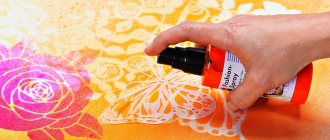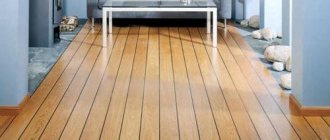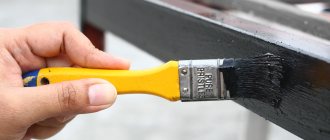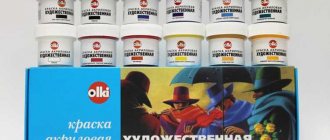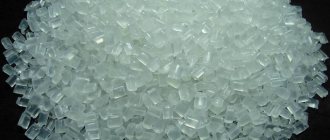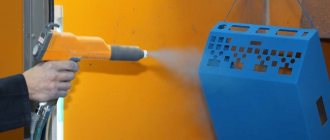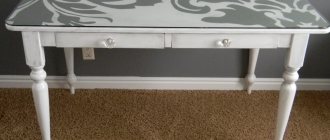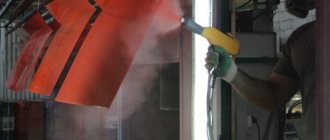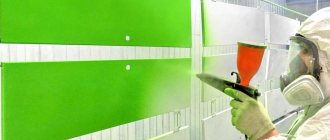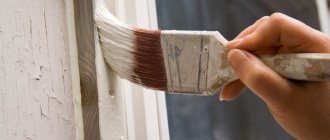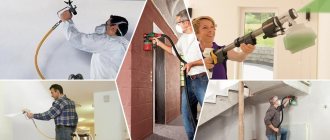Characteristics and composition of acrylic paint
Acrylic painting materials are used for finishing interior and exterior surfaces made of natural wood or its derivatives.
The paint contains:
- Water as a diluent for components.
- Pigments. Determine the color of the product.
- Acrylics. They bind water with color and impart characteristic properties.
- Resins of synthetic origin: protect against changes in color when exposed to sunlight.
- Plasticizers for layer elasticity. Thanks to them, cracks do not form on the surface.
- Hardeners. Accelerate the polymerization of the layer, increase strength and durability.
- Auxiliary components that give the paint the necessary characteristics.
Acrylic is washed off and diluted with water until it dries. After drying, a durable film with water-repellent and protective properties is formed. The dried layer is elastic and can withstand temperature changes, humidity, and ultraviolet rays.
The paint is absolutely harmless to health, which allows it to be used everywhere for interior and exterior work.
By clicking on the link, you can familiarize yourself in detail with the features of acrylic paints.
Composition and properties of paint
The composition of acrylic paints includes the following components:
- binders – aqueous dispersions of polymers;
- solvent – water;
- coloring pigment – titanium dioxide;
- filler – micronized marble and others;
- technological additives.
The binding element and its quantity are responsible for the basic properties of the composition - coating strength, vapor permeability, water and color fastness. For interior woodwork, paints with acrylic, styrene-acrylic and styrene-butadiene binders are used. Due to them, the coatings are elastic and durable.
Pigments are substances that give paints their color. The hiding power of the paint depends on the quantity and quality of the pigment. The higher this parameter, the less material consumption will be.
Fillers are various inorganic substances that are used to improve the properties of the coloring composition and save pigment. Fillers include chalk, talc, kaolin, dolomite, mica, and micronized marble.
Talc gives the coating resistance to cracking, marble – a high degree of hiding power after drying. High-quality paints are distinguished by finely ground and thoroughly mixed filler - they will be more opaque.
Technological additives give paints additional properties:
- dispersants increase shelf life;
- thickeners provide the necessary consistency;
- defoamers reduce the ability of a surface to foam
- preservatives and fungicides prevent the appearance of fungus on the tree;
- Solvents affect drying time.
Read more about acrylic paints >>>
Advantages and disadvantages of the composition when working with a wooden surface
The demand for acrylic products for painting wood is explained by many advantages.
Among them:
- Easy to use. No solvent is required; the required consistency is obtained by adding water. Apply with any tool: brush, roller, spray gun.
- A high level of adhesion ensures the durability of the coating, for which 2 layers are sufficient. The surfaces are evenly painted, no sagging or drips are formed. In addition to wood, it is applied to plywood, OSB, fiberboard, chipboard. The coating can be sanded and washed.
- Long service life: 5-10 years. Achieved through components that impart elasticity, resistance to water, ultraviolet radiation, and temperature fluctuations.
- Environmental friendliness and fire safety, allowing the use of solutions for interior finishing work.
- A wide range of colors - more than 1.5 thousand. Compositions are produced with a matte and glossy effect that imitate fabrics. You can create your own shade: white paint is used as a basis, to which the desired color is added.
The main disadvantages appear when stored incorrectly. Paint deteriorates if the permissible periods are exceeded or stored at sub-zero temperatures. If water freezes, after thawing the composition is unsuitable for use. When applied to damp wood, peeling is possible, since the level of vapor permeability of the paint does not allow excess moisture to pass through.
Comparison of different paints for wooden facades
In order to evaluate the advantages and disadvantages of acrylic paint, it makes sense to compare it with other compositions. Thus, for finishing and protecting the facades of wooden houses, three types of paint compositions made on an oil, alkyd and acrylic basis are most often used.
“Competitors” of acrylic paints – pros and cons
Oil paints
The main components of this type of paint are binders and coloring pigment. The binding component is most often drying oil, and the coloring pigment is a finely dispersed mineral powder that does not dissolve in the binder. This component is heavier than the binder, so a dense sediment will necessarily form at the bottom of the packaging container, and before using the paint, it must be thoroughly mixed. However, this quality is typical for most compositions.
Oil paint, despite the emergence of new compositions, still remains at the top of popularity
To choose the right oil paint, you should familiarize yourself with the parameters you should pay attention to:
- In addition to the main components, oil paints include film-forming components, which must account for at least 25% of the total mass of the paint. The higher this indicator, the more durable the coating will be, but these same components significantly reduce the viability of the solution after opening the package. When closed, the paint can be stored for a long time.
- In addition to film-forming substances, the amount of volatile substances is no less important. High-quality paint must have at least 10% of these components of the total volume of the solution. However, these substances, as a rule, are toxic and harmful to human health, their evaporation occurs at temperatures exceeding +20 degrees - this must be taken into account when planning painting work.
- The next indicator of the quality of the coloring composition is the degree of grinding of the coloring pigment. If the grind grain size is less than 90 microns, then the paint applied to the surface will create a smooth decorative protective layer, but if this figure is greater, the surface will become noticeably rough.
- The consumption of the coloring composition directly depends on the viscosity and fluidity of the paint, as well as on its hardening time. High-quality material, according to existing standards, must have a viscosity index in the range of 65÷140 units. (seconds). The drying time stated by the manufacturer should not exceed 48 hours or two days.
- An important property of oil paint is the hardness of the resulting coating. This parameter is especially important precisely in the case when the paint will be used for exterior decoration. The higher the declared hardness of the composition, the more durable the coating will be.
- Hydrophobicity for paints used for exterior decoration must be one hundred percent, but for interior work the composition may have a lower value.
Renewing the facade decoration of a wooden house with oil paint
Oil paint is almost always used to update an old wooden house that was previously painted with the same composition. The fact is that paints on a different base have lower adhesion rates to the old oil layer.
Among the characteristic features of oil paint, the following properties can be distinguished:
- The composition has good adhesion to a prepared (primed with drying oil) wooden base.
- There is a fairly low resistance to ultraviolet rays - the painted surface quickly fades and loses its original shine. Therefore, if this particular type of paint is chosen for exterior decoration, then it is best to stick to light shades - the fading effect will not be so noticeable.
- Freshly applied paint emits a persistent unpleasant odor, and it does not disappear soon.
- A surface painted with oil paint takes a long time to dry, so to prevent dust particles from sticking to the applied layer, such finishing should be done in calm weather, taking into account 1-2 days for drying.
- The maximum service life of an oil coating does not exceed 6–7 years, and under unfavorable natural conditions this period can be even significantly shorter.
Alkyd paints
Alkyd compositions are made on the basis of alkyd varnish, fillers, solvents and paint pigments. White spirit is most often used as a solvent; the same solution is added additionally when the paint has thickened.
Can of universal alkyd enamel
The main binding component in these compositions is alkyd varnish, which can be of two types - glyphthalic and pentaphthalic. For the production of household paints, pentaphthalic varnish is most often used - this is a thick resin diluted in a solvent, to which glycerin, rosin and oils are added.
The fillers added to the solution are often substances such as granite and marble chips ground into flour, sand or other materials with similar characteristics.
Alkyd paints are significantly superior to oil paints in terms of the degree of elasticity of the created coating.
Alkyd paints are characterized by good elasticity and durability; the surface painted with them dries quite quickly - this period is 6-12 hours, depending on humidity and ambient temperature. Surfaces coated with this paint do not fade during use, and the applied layer does not shrink.
Enamels made on the basis of alkyd varnishes are marked depending on their purpose, and, accordingly, differ in their properties.
- The area of application of alkyd paint is determined by its alphanumeric code. For example, the PF-115 marking can be deciphered as follows: PF is a pentaphthalic base composition, the first number “1” means that the paint is intended for outdoor use, and the number “15” is the enamel code in the catalog. The PF-115 solution is intended for wooden and metal surfaces - it creates a glossy coating on them.
In paint markings, in addition to one, other numbers are used - this is useful to know:
| The first digit in the numerical designation of paint | Decoding the features of the composition |
| 0 | Primer-enamel, which is used to prepare surfaces for painting. |
| 2 | Interior paint suitable for heated and unheated areas. |
| 3 | Enamels intended for temporary sealing of equipment. They are often called preservative compounds. |
| 4 | Enamels with pronounced waterproof and hydrophobic qualities. |
| 5 | Colorful compositions with special properties - glowing in the dark, repelling rodents and others. |
| 6 | Oil and petrol resistant paints. |
| 7 | Enamels with increased resistance to aggressive chemical environments. |
| 8 | Compositions with increased heat resistance. |
| 9 | Paints with special qualities are electrical insulating or, conversely, electrically conductive enamels. |
Alkyd paints are distinguished by their low price, which, in principle, determines their very wide popularity - it is this criterion that often becomes decisive when choosing a composition. In addition, the advantages include the following:
- Such paints have good resistance to weathering, high and low temperatures, in the range from -50 to +60 degrees.
- A variety of options - compositions can be matte, semi-matte or glossy. Gloss paints are ideal for exterior use, as they have a longer service life - about 20% longer than other alkyd enamels.
However, alkyd paints also have numerous disadvantages that must be taken into account when choosing a material for finishing a wooden facade.
- Such paints are flammable, meaning the fire hazard of the building increases.
- Alkyd paints have very low resistance to alkaline environments, and with modern precipitation this is not uncommon.
- Over time, the applied coating becomes brittle, loses its glossy shine, and yellowing and a web of cracks appear on it.
Surfaces freshly painted with alkyd paints can have rich, saturated colors. But in terms of external use, this beauty is not very durable.
- Alkyd solutions are not absolutely environmentally friendly materials. They have a rather unpleasant odor that persists throughout the entire period of complete drying.
- The painted surface will have a relatively short time between repairs - usually the period before the need for complete repainting is no more than 5-6 years, and even then - in almost “ideal” operating conditions, but in reality it can be much less.
And yet acrylic paints are much better!
Acrylic paints are synthetic water-soluble compositions made on the basis of high-quality polymer acrylic emulsions, which act as binders between coloring pigments and water.
Acrylic facade paints - many of the disadvantages of oil and alkyd compositions are eliminated
The composition necessarily includes special additional components that increase the performance of paints, as well as contribute to the stability of aqueous emulsions during long-term storage.
When acrylic paint hardens, it leaves a thin polymer film layer with a high degree of adhesion to the surface. This thin elastic coating becomes a reliable protection of the painted surface from external aggressive influences, and the coloring pigments included in the composition create the required decorative finish.
Of the types of paint under consideration, acrylic ones seem to be optimal for painting wooden (and not only) facades. This is due to a whole list of their advantages:
- Acrylic paints are highly resistant to atmospheric conditions, including the damaging effects of ultraviolet rays, and therefore retain their original color for a long time.
- The hydrophobicity of the created polymer film, along with its good vapor permeability, contributes to the timely removal of moisture from the wood, which significantly extends the life of the building - the walls do not get wet or become damp from excessive waterlogging.
- Acrylic paints are quite elastic, so the coating does not crack, maintaining its integrity during temperature changes, high humidity, and also when the walls of buildings shrink.
- Such compositions have good hiding power - application in two layers practically provides a complete guarantee of obtaining an evenly painted surface, even against a contrasting dark background. At the same time, the likelihood of getting paint drips when working with acrylic compositions is much lower than when using oil or alkyd compositions.
- The paint has no unpleasant odors and is an environmentally friendly material.
- The composition is easily diluted to the desired consistency. The base composition can be tinted independently in the chosen color by purchasing the necessary pigments suitable for acrylic paints. However, the best option would be to entrust the process of selecting paint colors to specialists who will carry it out using a computer method - achieving accurate tinting “by eye” is quite difficult, since when the composition dries, the paint tones and their saturation may change.
- The coating dries quickly, which significantly speeds up the work on painting the facade.
- The durability of the coating allows you to forget about repairing external walls for a long time.
Acrylic paints have practically no pronounced disadvantages, and what will be listed below can rather be attributed not to “cons”, but to recommendations for the use of compositions:
- You should not purchase paints from unknown manufacturers, even if they are attractive at low cost. We cannot exclude the possibility that after drying they may not only change the shade of the chosen color, but also lose the qualities characteristic of an acrylic coating.
- Subsequent layers of paint should be applied only after the previous one has completely dried, otherwise the overall coating may turn out to be too thick.
- Since acrylic paints are water-based, they should not be stored at subzero temperatures, as the composition will become unsuitable for use.
Find out how to paint a wooden floor with your own hands by studying the step-by-step instructions in the article on our portal.
What can you use acrylic paints on wood for?
The range of applications is wide. Acrylic paints are used for interior and exterior work, as well as in creativity and decoration.
- The compositions cover the walls of log, frame, and timber-lined buildings. They reliably protect the tree from precipitation, sun, and frost. They are used to decorate the structural elements of the house: platbands, overhangs, decorative fences on the terrace.
- Indoors, walls, ceilings, slopes, railings, stairs, interior doors, and windows are treated. Apply not only to the bare surface, but also to putty. The paint layer allows air to pass through well, so the wood breathes and rotting and mold do not begin to form.
- Acrylic is also used for decorative art painting and decoupage. They produce clear, colorful images that maintain quality for a long time.
- They decorate furniture. The surface is clean and uniformly colored. Fresh wood is often painted with glazing compounds: the structure of the material is emphasized and the desired shade is given.
What is acrylic paint: distinctive features of the composition
Acrylic paint is one of the types of water-based compositions. It replaced the oil coating. This paint is characterized by high performance qualities, thanks to which it provides reliable and durable protection of the wooden surface, giving it an aesthetically pleasing decorative appearance.
Acrylic compositions are water-based, they are characterized by reliability and durability
A distinctive feature of this composition is the water-solubility of the material, due to which the paint can be removed with water until the surface is completely dry. After the paint has completely set, it forms a protective, durable, moisture-resistant layer that is characterized by good elasticity. This feature allows the surface not to react to temperature changes and fluctuations in air humidity.
Possessing a unique composition, acrylic paints are characterized by a rich, bright palette of shades that do not fade or fade over time. The material can create a matte or glossy surface. There are also paints that imitate wood, satin or velvet. In addition, certain components eliminate the likelihood of cracking of the painted surface. The demand for this composition is also explained by the lack of toxicity and safety for human health.
Important! There is acrylic paint of a transparent color, thanks to which it will be possible not only to protect the surface, but also to emphasize its unique texture and natural shade.
Types of acrylic paint for wooden surfaces
There are 2 large groups of paints: for indoor and outdoor use. Intended for exterior finishing, they contain more special components that increase the durability of the coating and other characteristics. Among them are increased moisture resistance, protection against burnout, and temperature amplitudes.
A more detailed classification distinguishes:
- facade materials used to paint walls, building decoration elements, and other structures in the yard;
- universal - used indoors;
- acrylic enamels for wooden floors;
- paints for decoupage and wood painting.
Paints are not interchangeable; they have different properties. If used inappropriately, they will not last long.
Packaging containers are plastic buckets of various sizes, maximum 20 liters. Containers of 3-10 liters are in demand. Aerosol cans of paint are sold that are convenient for covering small items. They are used by decoupage artists.
Painting a wooden floor with acrylic paint
Advantages of using acrylic-based paints
The main advantages of using acrylic paints and varnishes include:
- Environmental cleanliness. This is due to the absence of harmful substances in the composition.
- Convenient and easy application. Acrylic-based paints and varnishes are odorless, which makes repair work more comfortable and safe.
- Fire safety. Acrylic does not burn because it does not contain flammable components.
- Wide choice of colors. A large selection of shades of the material makes it possible to use it not only for surface treatment, but also for room decoration.
- Drying speed. The period for complete hardening of the paint is on average 2–4 hours, which depends on the thickness of the applied layer.
- Wear resistance, elasticity and ease of care. These advantages increase the popularity of acrylic materials in construction.
- Formation of a protective film that promotes increased resistance to moisture.
- Long service life. In practice, it has been proven that coatings painted with German paints reliably serve for over 10 years without losing their aesthetic appearance.
- Wide range of applications. Acrylic materials have high protection against moisture, ultraviolet radiation and mechanical damage. They can be used both inside and outside buildings, at maximum humidity levels and under the influence of the sun.
- Universal application. Acrylic coatings can be used in combination with other types of building materials. When performing exterior or interior finishing, the compositions can be applied to almost all types of surfaces.
Rules for choosing water-based acrylic paint for wood
First of all, the objects to be painted are taken into account: external, internal, floors, for painting. They also pay attention to the hypoallergenic nature of the composition, which is planned to be used indoors, especially in a children's room.
For façade materials, color plays an important role. Take into account that the reflective ability of light-colored surfaces is greater. Therefore, for areas with a predominance of sunny days, light shades are chosen. Such compositions are less susceptible to ultraviolet radiation and will last longer. For the north, dark colors are preferable; surfaces warm up better.
When choosing paint, you can focus on the samples that sellers have. Just keep in mind that they are painted in 3-4 layers, so they look bright and attractive. If you apply 2 coats the look will be slightly different.
Acrylic products have a wide price range. It is better to refuse cheap formulations from unknown manufacturers: no one guarantees quality. The choice of the most expensive paints is not always justified. More important is what the paint is for. If for the facade, then it is periodically updated every 3-5 years. Therefore, it is not necessary to settle on an expensive brand; something in between with good characteristics will do.
In general, when choosing paint, it is better to follow the following algorithm:
- appointment;
- color;
- consumption;
- date of manufacture;
- shelf life and service life;
- manufacturer.
At the same time, they are studying prices. Choosing the right volume will help you save. It is always more profitable to buy 1 large bucket than several small ones. To figure out how much paint you need, measure the area before going to the store. They look at the consumption on the container and carry out calculations.
Priming wooden walls
The process of preparing a façade for painting includes the priming stage. In order to avoid making mistakes in this matter, you need to remember one rule: external wooden walls cannot be coated with a water-based primer. Only on oil.
As a rule, all high-quality primers are also antiseptics. Before you start, you need to carefully read the instructions on the package. The conditions under which priming with this product can be performed and the manufacturer's recommendations for application will become known.
Primer Tikkurila Valtti Akvabase (Valtti Aquabase)
Valtti Akvabase and BIOFA are considered one of the best primers for wood. These oil-based compounds can be used on any wood: freshly planed, pressure treated, heat-treated, old. When working with Valtti Akvabase, personal protective equipment must be used.
Special antiseptic primer for wood
How to Apply Primer to a Wooden Surface
For a small amount of work, you can use a paint brush with natural or artificial bristles to apply the primer. This tool is especially convenient when processing log facades. If the walls are smooth (plank or timber), you can apply the primer with a roller. This is not difficult to do.
Step 1. Pour enough primer into a paint tray or any other suitable container so that 1/3 of the volume of the roller roller can be immersed in it.
Mix the primer
Pour soil into the tray
Step 2. Dip the roller into the solution and roll it 2-3 times along the relief horizontal part of the paint bath. This removes excess primer, and it will not flow off the wall when applied.
A roller with a foam coat is an excellent tool for applying primer.
Step 3. Moisten a section of the wall by rolling a roller over it. Each subsequent strip should overlap the previous one by 5-7 cm.
Apply primer evenly
Step 4. Dip the roller into the primer again and squeeze it out. Next, work continues according to the given algorithm until the entire area of the facade has been processed.
Applying primer with a brush
Wood with fresh soil
Sand the primed surface after drying
It should be remembered that as little time as possible should pass between the processes of priming and painting. Not all primers are light and UV resistant. Therefore, they need to be covered with a layer of paint in a timely manner.
Prices for wood preservatives
Impregnation for wood
Wood surface painting technology
Those who are not sure whether it is possible to paint wood with acrylic paint should understand: this is the best composition, superior in its characteristics to others. If you follow the technology throughout the painting process, starting with surface preparation, the coating will not lose its strength and attractiveness for many years.
Tool selection
The paint is applied with a brush, roller or spray gun. Each of these tools has its own advantages and disadvantages. Let's try to figure it out.
Rollers and brushes
It is better to choose a brush made of synthetic bristles, which slightly absorbs water and is resistant to deformation. The next selection criteria are width and shape. Most people use flat brushes, in hard-to-reach places wedge-shaped brushes measuring 1.2 cm in size. For large volumes of work, buy a brush 15 cm wide, door and window blocks, corners are painted with a tool whose size is 2.5 cm. Before work, soak a new brush in warm water , the bristles become softer.
It is convenient to paint the ceiling and large flat surfaces with a roller. It requires a special tray with a ribbed platform to remove excess paint. For your first dyeing experience, it is better to choose fur rollers. The pile is medium in length, the width is selected depending on the size of the surface to be painted. Keep in mind that the larger the roller, the more difficult it is to work. To paint from the floor without a stepladder, buy a tool with a retractable handle.
Spray gun
Spray guns can be electric with a built-in compressor or airless. The paint in the latter is supplied due to the compression created by the engine. Another type is pneumatic spray guns, powered by a separate compressor with a receiver.
Each type has its own advantages and disadvantages. Airless spray guns are economical but expensive. During operation, a dust cloud with paint is formed, which settles on all objects around. The air type of tools does not have this disadvantage, but large drops of paint fly out of the nozzle and fall to the ground.
Simpler designs involve connecting a pump or vacuum cleaner. They are convenient for home use, operate quietly, and vibrate little. They are a gun with a handle, a nozzle and a tank, to which a hose supplying air is connected. The paint reservoir is small. The solution consumption, depending on the model, is 0.5-1.0 l/min. The recommended nozzle diameter is 0.5-1.3 mm.
Manufacturers of spray guns
Preparing the surface for painting
They start by inspecting the surface, then perform the following operations:
- Remove nails that will rust and show spots. If it is impossible to pull it out, they are hammered and treated with anti-corrosion compounds.
- Remove old paint. If it peels off, you can work with a sharpened spatula. The thick, durable layer is removed with a brush using a grinder. If the paint doesn't adhere well, you can use flap sanding discs.
- Damage and dents are repaired with putty and sanded after drying. The surface is leveled.
- Clean the wood from resins and degrease it with white spirit. The surface is treated with fire-fighting and antiseptic preparations. All products are applied only with a brush.
Log walls are not subjected to mechanical processing. Check how the space between the logs is sealed. If the sealing material is destroyed or weakened, it is restored with new one. Then they sweep away the dust from the walls.
Padding
Priming before applying the main paint layer is a mandatory step. Before work, carefully read the instructions on the container, paying special attention to the conditions for using the composition.
It is important to remember that for exterior work only oil-based primers are used; aqueous solutions can be used indoors.
Universal products - primers for wooden bases Valtti Akvabase and Biofa. Compositions with an oil base are suitable for priming any base: natural fresh or old wood, various slabs containing it.
The primer is applied with a brush or roller. The brush is convenient when working with uneven surfaces and log walls. If the base is flat and large in area, it is more convenient to use a roller.
The process is repeated. If you know how long it takes for the primer to dry, which is a maximum of 3 hours, you can plan your work so that you can apply the paint as early as possible. A long break is undesirable: many primers are not UV resistant. The treated surface is pre-polished.
Applying primer to a wooden surface
Technique for applying acrylic paint using a spray gun
Spray painting is fast, economical, and allows you to reach the most inaccessible places. Before starting work, preparation is carried out. Areas that are not to be painted are covered with film, secured with staples. Dilute the paint with water to the required consistency.
The viscosity of the composition is determined using a watering can, which is equipped with a spray gun. Close the hole in it and fill it with paint. Open the hole and calculate how long it takes for the solution to flow out. Optimal is 27 seconds. This indicator is achieved by adding 10% water to the composition. If necessary, add liquid several times until the desired result is achieved.
Pre-set up the tool:
- Set the regulator knob to the minimum, middle or maximum position. The speed of coloring depends on it.
- Plug in the spray gun and bring it to the area selected for testing at a distance of 50-60 cm. Press the button on the handle.
- Examine the results of the test staining. If leaks are detected, reduce the flow using the regulator.
Once configured correctly, you can paint. It is not recommended to fill the tank completely - the hand gets tired from the vibration. When painting, pay special attention to the recesses.
How to paint wood with acrylic paint: important recommendations
Before painting wooden furniture, a wall, a facade or other surface, you need to prepare paint, primer, putty, spatula, sandpaper, a container for the composition, a spray gun, a roller with soft bristles, a brush and a soft rag.
To paint wood with high quality, it is not enough just to choose a good paint. Of no small importance is a properly selected brush, which should ensure uniform application of the composition to the surface. For acrylic paint, the best option is a brush with synthetic bristles, which exhibits increased resistance to deformation and moisture absorption.
The next criterion is the choice of brush size. To treat volumetric surfaces, it is better to use a painting tool 15 cm wide. For narrow areas, a brush 2 cm in size will be sufficient. For painting door and window blocks, corners, it is better to purchase a flat tool 2.5 cm wide. For treating hard-to-reach places, a wedge-shaped brush will be the most convenient option (1.2 cm).
To paint an object well, you need to choose a suitable brush.
Helpful advice! Before use, it is recommended to soak the brush in warm water so that the bristles become soft and elastic.
To simplify the process of painting wooden surfaces, you can use an acrylic paint spray gun. Thanks to this tool, you can get a uniform coating in a short period of time.
There are three types of spray guns: pneumatic with a compressor and receiver, airless with an electric motor, and electric with a mini-compressor.
Important! Spray guns are not used for applying translucent and transparent compounds.
To save time and make the painting process easier, you can use a spray gun
Preparatory stage before painting a wooden surface
The process of painting any wooden surface consists of two stages: preparing the base and applying the coloring composition. Each process is carried out with utmost care to prevent warping or damaging the wood.
Before painting the wood, the base is prepared. If the surface has been previously painted, it should be cleaned thermally, mechanically or chemically. Damaged structural elements must be repaired or replaced with new ones. Next, the base must be thoroughly sanded to eliminate visible defects and irregularities. Wood dust can be removed using a vacuum cleaner.
If there are places on the surface with the presence of resins, they are cleaned and degreased using white spirit. The entire surface must be treated with fire retardants and antiseptics. Areas susceptible to damage and destruction should be coated with wax oil. All impregnations must be applied with a roller or brush in 2-3 layers.
Use wood putty to seal all cracks and cracks. The material is applied with a metal spatula. After it has completely dried, the surface is carefully treated with sandpaper or a grinding machine. Before applying the coloring composition, the prepared base should be treated with a quick-drying primer for wood for painting with deep penetration acrylic paints. The composition must be oil based. If necessary, you can use drying oil or stain.
Previously painted surfaces must be thoroughly cleaned
Important! The coloring composition must be applied only to a dry surface.
Acrylic paint on wood for interior and exterior surfaces: application rules
Painting the internal surfaces of walls, facades, ceilings and floors starts from the corner. Furniture elements are finished from the free edge. The surface is painted using an acrylic composition exclusively with horizontal strokes. The first layer is the base layer.
To increase the adhesive properties, it is recommended to dilute the composition. The second layer helps create a reliable base. It will hide all irregularities and defects. If necessary, it can be sanded with an abrasive material after drying. Finally, a finishing coat is applied.
To ensure uniform and uniform coloring, the composition is applied in long strokes with even pressure. Drops and drips are removed using a squeezed brush. The surface is covered with a new layer after the previous one has completely dried. To avoid the formation of air bubbles and drips, the base is painted in thin layers.
Acrylic paint must be applied in long horizontal strokes
To give the painted surface additional decorativeness, you have to decide what varnish can be used to coat water-based acrylic paint. For this purpose, an acrylic-based material is selected, which will not change the original color of the surface, but will make it more expressive. The varnish is applied using a flat brush with wide bristles, first on a small area, and then the material is slowly and smoothly polished until the tool sticks to the surface.
Varnish for acrylic paint is selected taking into account the area of use. When deciding how to coat acrylic paint on wooden furniture, you should choose special furniture options. They are designed for processing indoor elements. When thinking about what varnish to coat acrylic paint on the wood from which the floor is made, in this case, choose a parquet composition. It is able to make the appearance of the surface more expressive, giving it increased resistance to abrasion.
There is a universal varnish for acrylic paint that can be used to cover surfaces both indoors and outdoors.
The internal surfaces of a wooden house must be painted from the corner
The best manufacturers of acrylic paint for wood
The generally recognized leader in the production of high-quality acrylic compositions is the company Tikkurila from Finland. For interior work and painting furniture, choose Empire Base semi-matte paint with a slight sheen. Advantages: low consumption, many shades, fits well on the surface, dries in only 3 hours. Other quality products from this .
Teknos is also a Finnish company; its products are valued for their high environmental friendliness and lack of odor. The only drawback of acrylic products from Finland is the high price. A 0.9 liter jar costs an average of 800 rubles.
The German companies Alpina, Dufa, and the Austrian Adler are present on the market. Innovative acrylic products are offered by the American company Ace Paint. Its Contractor Pro Interior Wall paint can be applied indoors, except for wood, on drywall and brick.
Consumers speak well of the products of the Estonian company Pinotex ultra, the Slovenian Belinka, and the English Dulux.
Russian-made acrylic compounds are sold at lower prices. High-quality products are produced by Drevoplast, Yaroslavl paints, Aquatex, and Extra.
In addition to the material, the quality of the acrylic coating is affected by surface preparation and correct application of the composition. If you follow the technology, the paint will last the period stated by the manufacturer.
TOP 7: the best products from global manufacturers
Tikkurila EUro 7
Tikkurila group of companies is a leader in the production of paints and varnishes in Sweden, Finland and Russia. The association has been taking care of saturating the market with high-quality and safe products more than 150 years
Bestseller - Tikkurila EUro 7 - matte paint for walls and ceilings in dry rooms. Great for painting wallpaper. Currently, Tikkurila EUro 7 is discontinued and replaced by Euro Power 7 .
The new product is recommended for rooms that require frequent wet cleaning using non-abrasive detergents. The composition is suitable for application on concrete, plaster, brick, plasterboard, fiberboard and chipboard . For tinting, there are 20,000 colors from the Tikkurila Symphony .
Consumption for one layer: from 10–12 m2/l on a flat non-absorbent surface to 7–8 m2/l on an uneven absorbent surface. Diluted with water, dries in 1.5 – 2 hours under normal conditions.
Deckfarbe
Remmers GmbH is a leading German manufacturer of construction chemicals. He considers his motto to be maintaining excellent quality and creating high-tech mixtures.
Deckfarbe series is popular - water-based compounds with high weather resistance. They have good hiding power, water resistance and abrasion resistance. Dries in 3-4 hours . Consumption depends on the type of base, on average 100 ml/m² per layer.
Forwood
Novosibirsk is a leader in the Siberian market of paints and varnishes and is well known for its products. Among them, compositions for wood FORWOOD .
FORWOOD 0.9 L. BASE “A” - acrylic matte paint, has a service life on the facade of up to 7 years and a self-cleaning function with sediment, intended for interior and exterior work, has many advantages:
- odorless, environmentally friendly and fireproof;
- forms a wear-resistant elastic vapor-permeable coating;
- has excellent adhesion to any wooden surfaces, putty, concrete, brick;
- contains an antiseptic and water-dirt-repellent additive.
The paint also has a high degree of hiding power - one liter is enough to cover 6-8 square meters. m. surface. The coating dries quickly - no more than 1 hour under standard conditions.
Respect
Manufacturer: Moscow region. The company's motto is product availability for any client. The company produces building materials, including acrylic compounds for wood.
Respect paint is intended for painting ceilings and walls in residential and non-residential premises. Fits well on all types of prepared surfaces. Vapor permeable, lightfast, environmentally friendly. Painted surfaces are not affected by fungus. Material consumption – 150-200g per 1 sq. m. , the coating dries completely in 3 hours .
Marshall Maestro
Marshall is a paint and varnish brand within the AkzoNobel . The holding is focused on the production of affordable building materials for both professionals and ordinary buyers.
Marshall Maestro Interior Classic – acrylic water-based paint. Easy to apply and does not form streaks or marks. It has good adhesion to wooden and mineral substrates and is suitable for painting wallpaper without hiding its texture. Dries completely in 4 hours at a consumption of 1 liter per 9 square meters. m.
Adler Lignovit Color
The Austrian company Adler offers paint and varnish products of excellent quality for the European and Russian markets. The company's constant technological improvement helps achieve this.
Adler Lignovit Color paint is intended for exterior and interior use. It is highly resistant to atmospheric influences and contains light-resistant pigments and antiseptics. Elastic and does not peel off. Its consumption is minimal - only about 100 g / 1 m2 . The coating dries in 3-4 hours .
Optimist
The group is a large domestic manufacturer of goods for repair and decoration. The organization focuses on the production of high-tech materials to meet all customer needs - from simple cosmetic repairs to exclusive interior work. At the same time, the manufacturer tries to maintain the most affordable prices for its products.
The Optimist brand produces washable interior acrylic paint for wooden surfaces. At a low price, it is very economical - only 150-200 g/1 m2 of surface is consumed.
Advantages of acrylic paint
Water-based and acrylic-based paints and varnishes are designed to cover all surfaces that contain wood. This can be solid wood, slabs and plywood. In this case, the complexity of the shape and the condition of the material do not matter much. In any case, the quality of work will always be at the required level.
Such characteristics are achieved thanks to the following advantages of acrylic paint:
- Environmental cleanliness and safety. This is a significant factor that is always taken into account when choosing the right type of paint and varnish materials. Due to its chemical and biological inertness, wood paint for interior work is the most common choice of developers and renovation teams of any level.
- Ideally even distribution over the surface of the processed material. Water-based paints do not leave gaps, drips or streaks.
- Preservation and emphasis of wood structure. The polymer liquid easily penetrates even into microscopic recesses. This is appreciated by craftsmen who want to maintain the general style of external and internal decoration.
- Air permeability. This quality is very important for those who build houses from natural wood. The wood continues to breathe even after applying several layers of paint. Dampness does not accumulate inside the room and a comfortable microclimate is maintained.
- Durability. Acrylic paint for wood for external use is resistant to weather conditions. It does not lose its characteristics under the influence of moisture, ultraviolet radiation, high and low temperatures.
- Excellent protection for treated surfaces. Painting wood with acrylic paint creates a protective layer that protects the structure from dampness and insects. Dirt does not linger on this layer. Acrylic for wood is a kind of regulator that protects it from uneven drying and cracking.
- Wide range of colors and textures. Wood paint for exterior use can be matte or glossy. You can choose any coating color that is most suitable for processing a particular object.
- Variety of release forms. We are talking about the size and shape of the package. To process large areas, it is advisable to purchase products in buckets and barrels. In order to do a small job, it is better to buy paint in cans.
- The product goes on sale already in a state of readiness for use. It can be used in work immediately after delivery to the site.
Moreover, even the highest quality paint for interior work has a very affordable price.
Basic properties
Applying a coating (paint and varnish) to wooden surfaces is necessary to protect against destructive factors, protect against microorganisms and, of course, to update the color and give a beautiful appearance. Painted wooden surfaces become more stable and do not deteriorate from moisture.
Application of water-based paint for interior work Source www.solvay.ru
Wood paint for interior work is available in two variations:
- water-based – based on liquid polymers;
- water-dispersion - based on solid polymers.
These two versions are similar; as they dry, moisture evaporates and the plasticizers acquire hydrophobic properties.
Wood paint intended for interior use is a special type that is characterized by safety, instant drying and uniform, easy application to the prepared surface.
With the modern composition, the surface will be ready within 2 hours after application. As a result, you get a dense layer that does not allow water and steam to pass through. At the same time, it is safe and can also be used in a children's room.
Water-based paint Source www.interieurdesigner.be
Wood coatings are divided into matte and glossy, and also into subtypes - semi-matte and semi-gloss, which are used in their own way in the interior. Manufacturers produce mixtures with special qualities, for which several components are added to the paint - fire retardants and antiseptics. Fire retardants make it possible to reduce flammability, and antiseptics protect wood surfaces from the occurrence of fungi and mold.
Polyvinyl acetate coloring composition
Its base includes a mixture of oil and water (PVA), due to which the painted surfaces are stable and durable, and are easy to wash. Polyvinyl acetate composition is a quick-drying paint that is good for use in wet areas (kitchen, bathroom, toilet).
Polyvinyl acetate paint for wood Source 1povagonke.ru
Pros:
- no unpleasant odor;
- fireproof;
- does not fade;
- has a high adhesion coefficient;
- can be tinted.
Minuses:
- low coefficient of stability to water;
- After drying, a chalky effect remains.
When drying, the moisture from the dye evaporates, as a result of which the structure hardens and becomes durable, and a semi-matte porous layer is formed. It will only take a few hours for the composition to dry completely (2-3 hours).
Latex paint
This variety is considered one of the subtypes of water-dispersed materials, where latex acts as the main inclusions. Advanced dyes use an artificial type of latex, which is dispersive particles of synthetic rubber. Such odorless paint for interior work is not toxic, and therefore is always used for any interior work.
Latex paint for wood, odorless Source gidpokraske.ru
See also: Catalog of house projects made of double timber with painting
Pros:
- mixes with other dyes;
- resistant to moisture;
- resistant to damage.
Minuses:
- not resistant to ultraviolet rays;
- Application - exclusively with a roller in 2-3 layers.
Latex wood paint in two layers Source kraski-tula.ru
This is an excellent option for creating a long-lasting and durable surface that is easy to clean and retains its original shade for a long period. It does not dry out, does not swell, it is rational to use it when decorating rooms with high dampness - kitchens, bathrooms.
Latex water-based emulsion is thoroughly embedded in the wood texture, creating a waterproof film that perfectly protects furniture from getting wet and makes it possible to wash it with a damp cloth.
Silicone dye
This flexible, odorless paint can be used to cover small, shallow cracks in floors and walls. The reliable silicone shell will not collapse under the influence of humidity, including in the case of direct contact with water, it resists the influence of ultraviolet radiation well, but at the same time it is highly permeable to air and water vapor.
The silicone composition, in its physical properties and technological data, has significant similarities with acrylic ones, but differs from them in the denser and brighter colors, and in addition, it is highly resistant to weather conditions and has improved performance properties.
Odorless silicone paint Source dekormyhome.ru
Pros:
- UV resistant;
- has dielectric properties;
- resistant to dust, dirt, alkalis;
- long service period (20–25 years);
- universal and suitable for various surfaces.
The disadvantage is the high price.
What criteria are used to choose paint?
When purchasing acrylic paint, you need to decide on the purpose of its use. As a rule, the buyer pursues the goal of protecting a house or other object from mold and giving it an attractive appearance. First of all, the user pays attention to the quality of the paint, which should not contain harmful substances and reliably protect the painted surface from the influence of the natural environment.
Acrylate paints for painting facades must meet certain requirements. They should make it easier to care for the house and extend its life.
These paints must have the following characteristics:
- Apply to the surface in a uniform layer;
- The presence of non-volatile substances in them should not exceed 74%;
- Possess frost resistance and light resistance;
- Dry completely no later than after 30 hours;
- Service life on the façade surface is up to ten years.
In addition, acrylic paint must meet the requirements of European standards. It should not emit a pungent odor during operation. Therefore, when choosing which paint is best for wood coverings, you need to carefully familiarize yourself with its composition, give preference to well-known manufacturers, focus on the economical consumption of the coloring material and check the quality certificate from the seller.
Unfortunately, there are paints on sale from unscrupulous manufacturers. Therefore, it is advisable to purchase materials made in English, Finnish, Estonian or Russian, and not from Chinese suppliers.
